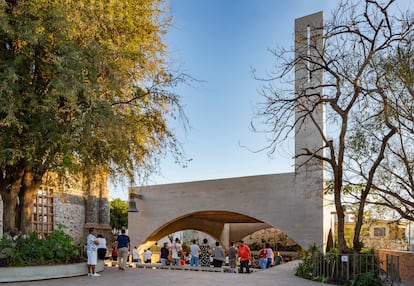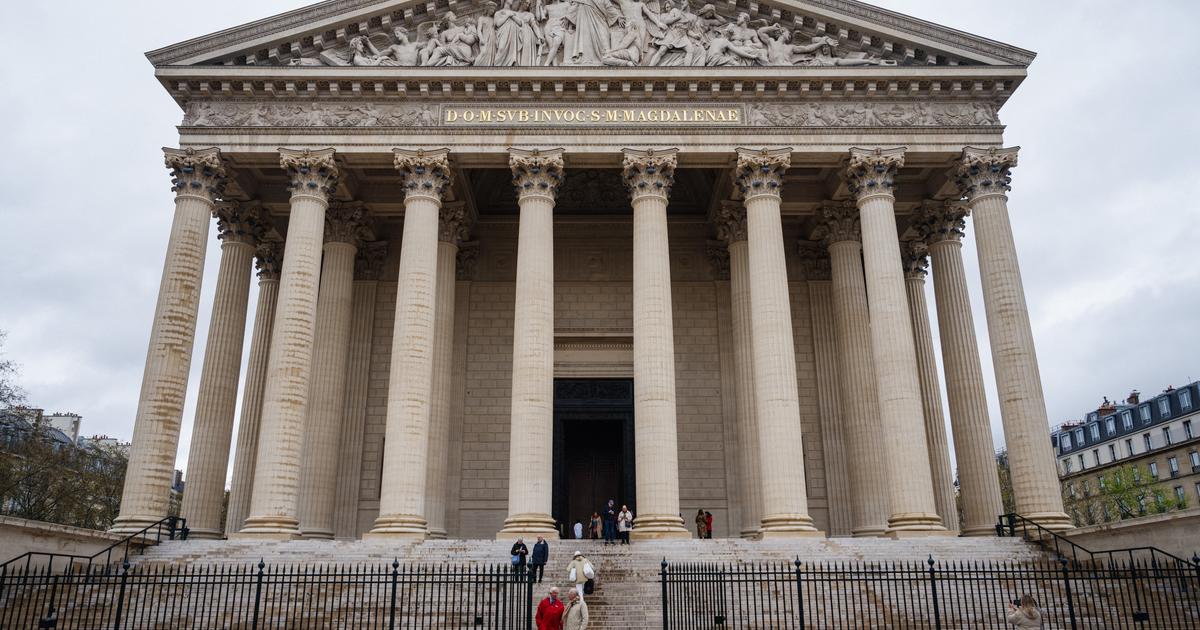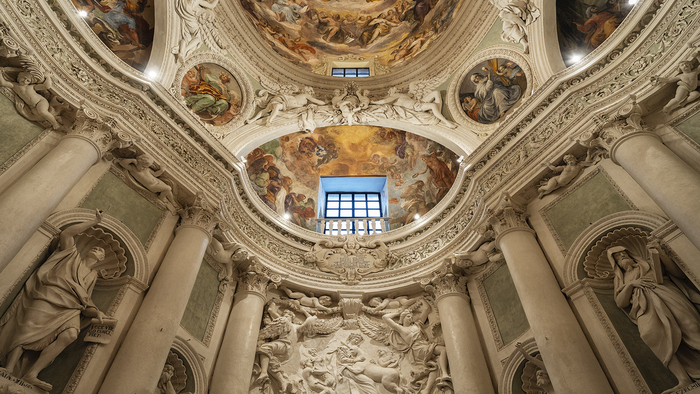More welcoming than dazzling, in contemporary churches touch seems to have replaced sight.
Above being admired, the new temples seem made to be touched.
It is humility that attracts attention.
Austerity today seems more convincing than opulence, while religion itself is becoming blurred in temples with a more spiritual —and ecumenical— identity than representative of an unwavering faith.
Mario Cucinella describes his church of Santa Maria Goretti di Mormanno, in the Calabrian national park of Pollino, as the austere and contemporary version of Borromean curves. Goretti, who only lived 12 years, is the youngest of the Catholic saints. Having been a lay girl, the reason that prompted her canonization is not trivial: she died at the hands of her sexual aggressor. Reality has entered the Church to come closer to the consolation of believers. And that message is communicated from the architecture. As was the case in the past with power —or, if you prefer, with faith—, now a great scenery of authenticity is being built. This church is entered through a cross that is actually a cut in one of its four concrete apses.Four curved walls fill an empty and austere space invaded by the light from above that filters not through colored windows, but through a cloudy sky with white veils. Thus, the outer temple, the one that can be seen, is resounding and monolithic. But not all its greatness is seen. The little is chosen to communicate and under a vegetable soil the parish facilities connected underground with the church are hidden.
Church of San Giacomo in Ferrara by EMBT.
Roland HalbeRoland Halbe
Inside, the baptismal font or the sculpture of the Virgin by Giuseppe Maraniello do not compete with the play of light under the veils and it is this bare frame that is assimilated as a spiritual quest.
But that truth contains other certainties such as the low maintenance cost and the high visual impact of the sober.
The apses, white on the outside and exposed concrete on the inside, seem designed to support the intangible cross that is the entrance and that turns the temple into a night claim.
That raw design is softened by the kindness of the curves that sinuously run through the states of faith.
Also convened by the Italian Episcopal Conference (CEI), in Ferrara, Benedetta Tagliabue and her EMBT studio won the competition to build the church of San Giacomo. The objective —explicit in the program— was to achieve closeness with the people, to achieve the revitalization of the creed. True to his ideology, Tagliabue responded with a nudity that was more topographical than simple. Constructed of concrete and lined with bricks that, like scales, increase the feel of the building to the point of giving it the appearance of a living being, this organic church welcomes visitors. It receives them by unfolding a radial cover, a fan of parabolic vaults crowned by the large skylight that illuminates the suspended cross. Between poplars, faith is recycled and so are the materials that build arte povera with poverty. The wood of the cross comes from the works of the consistory,and, from the hand of the trans-avant-garde painter Enzo Cucchi, art seeks in abstraction. Nothing is new, but everything is experienced as a new reality. It seems like an austere subtraction, but the artistic ambition is on a par with the temples that have made history. That is the key: speak from the moment and not from the story in order to continue telling the story.
Sanctuary of the Lord of Tula in Jojutla (Mexico) by Camilo Restrepo, Dellekamp/Schleich and AGENdA.
Sandra Pereznieto
Thus, there are many temples that do not ask.
But almost all offer answers, not impose them.
Decades ago the Church began a journey far beyond comfortable abstraction.
From the hand of lightness, Shigeru Ban understood that the believers of Christchurch, in New Zealand, feared a new earthquake more than the devil.
That is why the Japanese built their cathedral with cardboard tubes and what was planned as a temporary temple ended up becoming the cathedral of another time.
These are buildings that do not ask.
But almost all offer answers, although they do not impose them
Something similar happened in Jojutla (Mexico), where, after the 2017 earthquake, Camilo Restrepo and his team decided that it would be the roof that would welcome the faithful and the emptiness of the temple that would give them security. Little more than a roof, the most basic image of an architectural shelter - the primitive hut drawn by Abbot Laugier as the two inclined planes that form a roof or the two hands that we join above our heads to protect ourselves from the rain - is the shape that the Portuguese study Plano Humano Arquitectos used for the chapel of Nossa Senhora de Fátima in Idanha-a-Nova, in the center of Portugal. Not by chance, the architects of the Mapa studio also used these inclined planes as the only elements to build their Sacromonte chapel, in the facilities of a hotel located in the Sierra de Carapé in Uruguay.
In Helsinki, the Kamppi chapel of the K2S studio has an oval floor plan. And, even without a creed or precisely for that reason, it is a space as psychological as it is spiritual. It is next to the central station and, lined with wood and without any religious attributes, it is designed so that citizens can find a few minutes of peace in the midst of the hustle and bustle of the city. More a cave than a cathedral, there are many temples that are now committed to offering a protection that their architecture also wants to communicate. “A humble cabin made with reeds and raw cement. An enveloping, archetypal and spiritual space that inspires recollection but is full of light”. This is how Tagliabue describes his new temple in Ferrara. The definition could be applied to the updating of the faith and to the new churches. It is the light and the simple to make a refuge of a truth.But it is also the artistic, the creative, from the hand of architects, sculptors, landscapers and painters. It is about offering comfort and communicating it. But also to keep dreaming.
You can follow BABELIA on
and
, or sign up here to receive
our weekly newsletter
.
Sign in to continue reading
Just by having an account you can read this article, it's free
RegisterLogin
Thanks for reading THE COUNTRY









